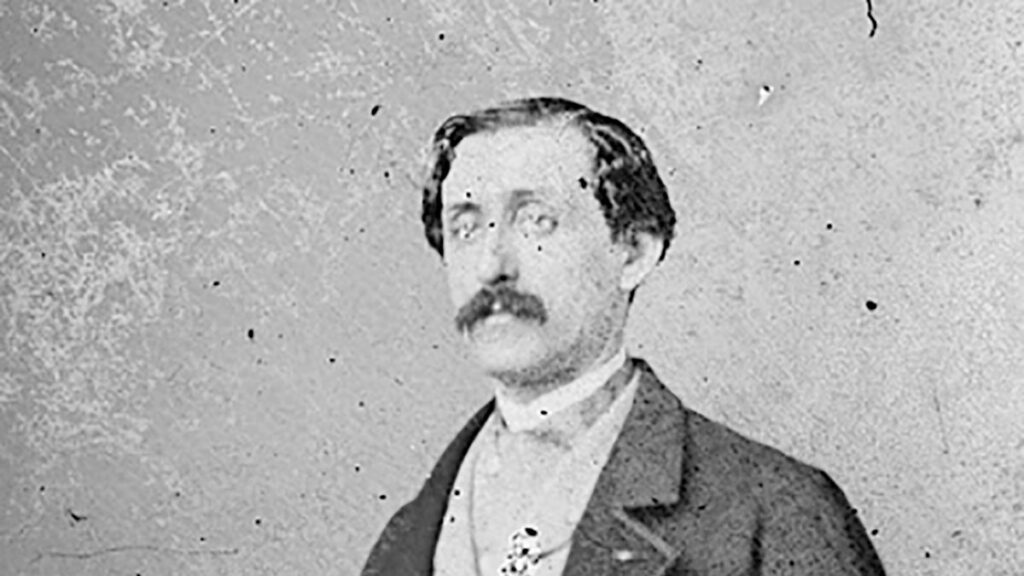Louis Moreau Gottschalk (1829-1869) was the first internationally recognized American pianist. He was also the first classical composer to notate the rhythms of Congo Square and other Latin rhythms on his travels through Latin America. He died in Brazil.
Louis Moreau Gottshalk was a Son of New Orleans

Gottschalk was born in New Orleans on May 8, 1829 to an Jewish German English father and a French Creole mother. His grandmother and nurse were Saint-Domingue Creoles, meaning Haitians from the French Colonial Era.
His childhood home on 518 Conti Street in the French Quarter’s Tremé neighborhood was about half a mile from Congo Square, now Louis Armstrong Park.
Congo Square (Place Congo)
Congo Square was an open area in what was then the outskirts of New Orleans where Africans and African Americans gathered to hold a market on Sundays. They eventually began to celebrate life in traditional African ways.
Since the Africans came from the entire west coast of Africa, they often didn’t speak the same languages, but everyone understood the drum. African drum, song and dance traditions are not really about drumming, singing and dancing. They are about connecting with nature, family, friends, community and love. African dancing is an expression of your unique identity within the community.
In Congo Square, African descendants danced Bamboula, Calinda, Congo, Carbine, Juba and other rhythms. We have a lot of rhythms.
All kinds of instruments were made and played Congo Square. There were drums, banjos (which is African origin), flutes, marimbas (African origin) and some European instruments too. A lot of people dressed their finest. We still do the same thing today.
The locals had never seen anything like African drumming, singing and dancing. 500-600 Africans would assemble and dance. Place Congo even became a tourist attraction for a while.
Congo Square was where African and European traditions began to blend into African American culture. It’s the beginning of what became gospel, ragtime, blues, jazz, country, rock, salsa, hip-hop, reggaeton and Latin trap. All of this springs from the creativity of the African diaspora.
Gottschalk Was the First to Notate African Rhythms
Gottschalk was a musical child prodigy. His family home happened to be near New Orleans Congo Square, so he grew up listening to all those rhythms.
Being a European American, the pianist was able to get classical music training in Europe. He really was a classical musician, but in the American tradition, not the European one. Again he was the first. At first the Europeans looked down on him for being American, but he was eventually well received. Renowned romantic composer Chopin predicted that Gottschalk would be the king of the pianists.
It makes sense because African music emphasizes percussive rhythms and the piano is actually a percussion instrument. The hammer at the end of the piano keys hits the string.
When Gottschalk returned to the States, he toured extensively. His work feeds into ragtime. He was one of the most popular American composers until audiences realized he was part African descent.
Our country was even more racist than it is now, so the pianist turned his focus to the Caribbean and Latin America. He traveled through Cuba and Puerto Rico where he composed “Souvenir de Porto Rico: Marche des gibaros, Op. 31.” Jíbaros are the mountain farmers who are the iconic Puerto Rican folk character. What an interesting look into a past that is mostly hidden in time.
Gottschalk’s most famous composition is “Bamboula, Op. 2.” It’s the “Danse Des Nègres” (Dance of the Blacks). Listen to how much it sounds like ragtime.
His work can be hard to play because he captures the percussive nature of the music, and African polyrhythms. Polyrhythms are difficult to play. Try beating out rhythms in 2, 3 and 5 at the same time. We’ve seen artists like Pedrito Martínez and Bobby Sanabría do it. They must have two or three brains.
Gottshalk died of yellow fever on tour in Rio de Janeiro, Brazil in 1869. He is buried in Brooklyn’s Green-Wood Cemetery.
